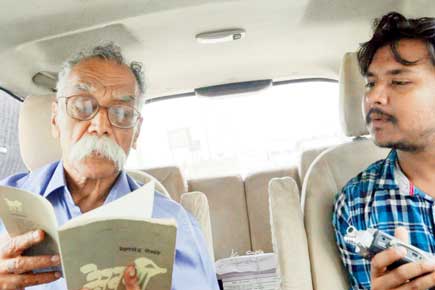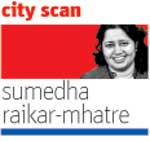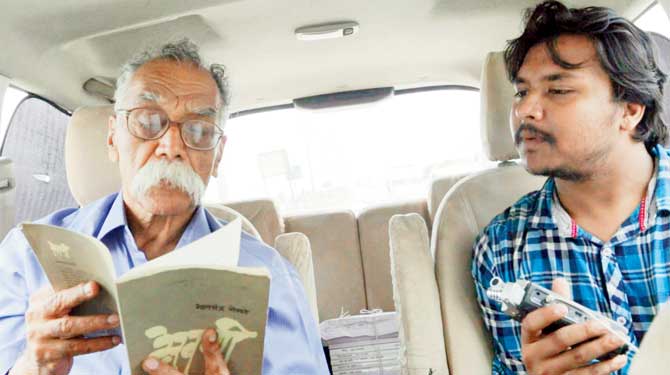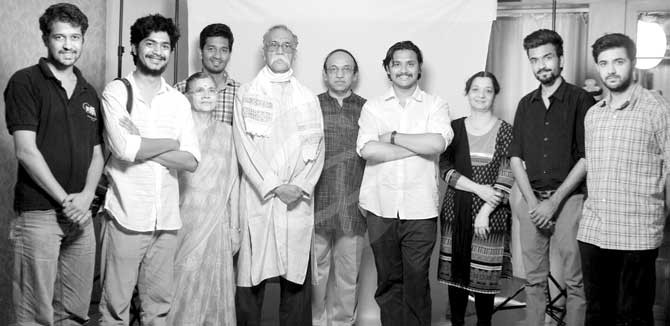A docu-fiction captures the life of Bhalchandra Nemade, with the camera following him to his home, village and even on reunions with friends

In the part documentary-part fiction film, Nemade plays himself while characters from his works come alive
 Jnanpith award-winning writer Dr Bhalchandra Nemade was asked by mediapersons about his take on the renaming of Aurangabad in September 2015. Nemade inquired if the city’s civic problems were over and renaming was the only governance issue left to tackle. He observed that renaming is the business of idlers and shirkers who add to the postman’s work hours. Journalists laughed over the line, now saved in a database of in-your-face Nemadespeak. The comment became unedited footage for Akshay Indikar’s 90-minute docu-fiction film (while Nemade plays himself, some of the characters from his books are also portrayed by actors) on the living Marathi litterateur, who recently turned 78.
Jnanpith award-winning writer Dr Bhalchandra Nemade was asked by mediapersons about his take on the renaming of Aurangabad in September 2015. Nemade inquired if the city’s civic problems were over and renaming was the only governance issue left to tackle. He observed that renaming is the business of idlers and shirkers who add to the postman’s work hours. Journalists laughed over the line, now saved in a database of in-your-face Nemadespeak. The comment became unedited footage for Akshay Indikar’s 90-minute docu-fiction film (while Nemade plays himself, some of the characters from his books are also portrayed by actors) on the living Marathi litterateur, who recently turned 78.
ADVERTISEMENT

In the part documentary-part fiction film, Nemade plays himself while characters from his works come alive
In a montage of personality traits — a visible dislike for smartphones and CD players; admiration for Begum Akhtar; an iconic Marathi Reading Course for the “research student in a hurry”; his rejection of the short-story genre — we experience an electrifying literary genius credited with the epoch-making Marathi novel, Kosala (Cocoon, 1963), translated into English and eight Indian languages. Kosala’s impact on the director is visible in the title, Udaharnarth Nemade (For Example Nemade), which vibes well with the funny-on-the-ears Ahirani lingo (a Marathi-Hindi-Gujarati mix) spoken by Kosala’s hero, Pandurang Sangvikar.

The cast and crew of Udaharnarth Nemade (For Example Nemade) with the writer and his wife Pratibha. The film’s director Akshay Indikar is standing to Nemade’s left in a white shirt.
Before this month’s release, Udaharnarth has earned a slot in the Goa Marathi Film Festival, scheduled this weekend. It is Indikar’s first full-length project after he quit Pune’s Film and Television Institute course mid-way in 2014. The 25-year-old awaits sponsorship for his ambitious plan to hold city-wise screenings followed by discussions. “It’s a chance to shoot a prodigious writer in real time and fathom his creativity. Locked in a room for 15 days, he wrote his first novel at 25. His researched for 31 years for the epic, Hindu, which he wrote in his seventies and it is the first part of his unfolding quartet. Teaching English was his livelihood; writing Marathi, his passion. He is zapping,” says Indikar, who prides on the light moments that came from the animated conversations with the crew that shot his daily life for 35 days at a stretch.

A poster of the film created by Amol Thakur
The much-feted literary giant (Padmashri 2011; Sahitya Akademi 1990) made himself available with wife Pratibha for off-line interviews, (one exceeding eight hours) which provided the perspective heft. He allowed the camera to follow him during engagements in Nagpur, Pune, Bhusawal, Goa, Aurangabad and Mumbai, particularly the post-2015 Jnanpith public speeches in which he explained his theory of Deshivaad (Nativism) as against right-wing parochialism. Apparent is the tight handshake between a septuagenarian and a team of 20-somethings who were given the keys of the Nemade ancestral home at Dongar Sangvi (Jalgaon district). The film exemplifies a living litterateur’s connect with his fans who not just quizzed him for hours over the genesis of Kosala, shooting in the room in which he wrote it, and seven other creations, but also dared to ask him questions about his doubts and cigarette addiction. Nemade’s robust trademark moustache also came into the ambit of inquiry, motivating artist Amol Thakur’s film poster, titled Deshi Mishi (The Native Whiskers).

A still from Udaharnarth Nemade in which actor Sanjay More plays Kosala’s hero, Pandurang Sangvikar
“We listened to songs on his tatty tape recorder; discussed mass media trends; he asked us about camera angles and editing-mixing processes. When he visited school friends, we were privy to the intimate banter,” recalls Indikar. From a middle-class family in Solapur, Indikar migrated to Pune to study, somewhere close to the transition of the protagonist in Kosala, and that’s why feels motivated about the film project. His student film, Doh, won him kudos, but otherwise he is a novice. Two years ago, Indikar sought Dr Nemade’s permission to use his poems in an upcoming autobiographical feature film. While he went after a few poems, he ended up getting a big catch. Nemade validated his idea of docu-fiction. “He connected with my phase and age — the same one in which he had given birth to the Kosala’s hostelite hero whose daily diary entries forever changed Marathi readers’ perception of rural youth pursuing higher studies in metros.”
Udaharnarth… is a non-linear narrative populated by characters and motifs created by Nemade over five decades. It focuses on road journeys that are central to Nemade’s theme of urban migration. It gives visual form to his romantic poems (Dekhani) in a mythical character (played by actress-model Ketaki Nar-ayan). FTII graduate Sanjay More assumes the persona of Nemade’s male heroes who go close to the younger Nemade.
The reel element runs parallel to the real Nemade on screen — reciting poetry, visiting neighbors, talking politics and taking to the Pune-Mumbai expressway.
The film captures the Nemade couple taking potshots at each other. “Disarmingly honest, they make no effort to become the ideal pair. He is at his acerbic best in recounting the unromantic reasons for choosing her; she recalls the first time she taught him how to use the pressure cooker.”
Nemade’s village connect is endearing. “Dongar Sangvikars respect his rising status, but not fawningly. During his overnight village stays, the unearthly 4 am temple bell ring is given a miss, so that his sleep is not disturbed.” He entertains all and sundry, unlike his time management in Mumbai. The film shows his chat with a schoolgoer who was asked for a bribe by his examiner. A disturbed Nemade warned him: “It’s better to fail than pass this way.” The crew could connect his anger with the theme of corruption plaguing his protagonist Changdev Patil in the quartet novel series.
Udaharnarth... honors an Indian writer who lives up to his brand of nativism — embraces rural roots, shuns urban sophistication and promotes the potency of the mother tongue as the truest form of expression. His earthy Ahirani makes us wonder if he is the same person who taught Tukaram to student’s at London’s School of Oriental and African Studies.
Sumedha Raikar-Mhatre is a culture columnist in search of the sub-text
 Subscribe today by clicking the link and stay updated with the latest news!" Click here!
Subscribe today by clicking the link and stay updated with the latest news!" Click here!






